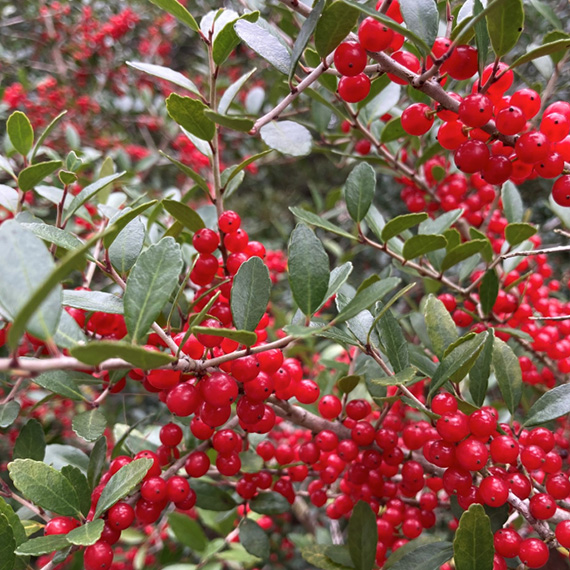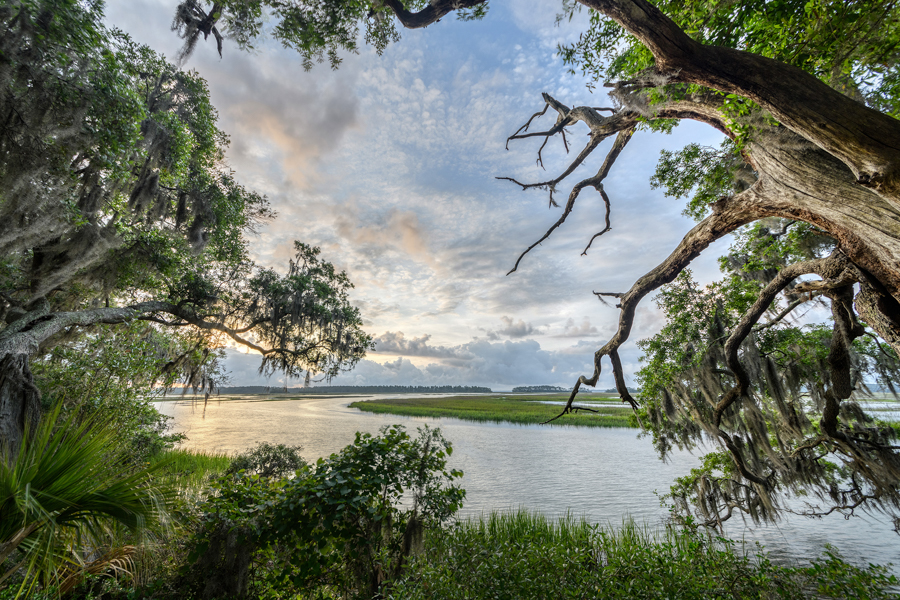Palmetto Bluff Real Estate Company Sales Office
Office Hours
Monday-Friday 9am - 5pm
Saturday 9am - 4pm
Sunday 12 - 4pm
Saturday 9am - 4pm
Sunday 12 - 4pm
Whether they grow as shrubs or trees, black willows are typical willows, with elongated leaves and slender trunks. However, the distinguishing feature of this tree is its dark, furrowed bark – known for its medicinal benefits.
Native to South Carolina and found at Palmetto Bluff, Jay Walea, director of the Palmetto Bluff Conservancy, tells us more about black willow.
Native (but Invasive)
Although native, this plant can be invasive, growing in thickets along our freshwater riverine systems and lagoons. This species has an amazing ability to take over the edges of rivers and lagoons for several reasons. The seed from the willow is dispersed in the air but will also fall in the water – taken downstream by the current before being deposited along the bank. Twigs and limbs of the black willow, should they fall, can take root and become a new tree. And if the black willow has been cut down, new growth can sprout from its stump. All of these dispersal methods give this tree species a great survival mechanism.
Natural Remedy
Since the time of the ancient Greeks, black willow has been used for its medicinal properties. A tea made from the bark of the black willow has been used for centuries to combat stiff joints and rheumatic pains. The new growth on the ends of each branch, along with the bark, has salicylic acid which is a natural form of aspirin. Chewing on the new growth or making a tea from the new growth or bark has been used as a fever reducer and a pain reliever.
Erosion Prevention
Black willow has other benefits rather than its beauty and its medicinal value. This species only likes moist soils and has been used for soil stabilizers to keep banks from eroding. Growing along the water’s edge, this tree has limbs that drape over the water (and often into the water) providing escape cover for small fish to get away from larger predatory fish found in these systems.
When controlled, black willow is a great tree with many benefits and adds beauty to the South Carolina Lowcountry.

Warm, fragrant, and deeply comforting, Chef Beth’s Southern Sausage & Sage Stuffing is a holiday classic that brings together rich pork sausage, fresh herbs, and toasted bread for the ultimate savory side dish. Studded with green apples and aromatic vegeta...

As December settles over Palmetto Bluff, it brings softer light, cooler mornings, and the natural beauty of native evergreens and winter berries that define the Lowcountry landscape. Palmetto Bluff Conservancy’s Education and Outreach Manager, Aaron Palmier...

In 2025, Palmetto Bluff welcomed new neighbors and old friends, groundbreakings, and long-awaited openings. From inspired Club gatherings and elevated programming to the creation of our latest golf course, the year was defined by connection and excitement for ...

There is something serene about waking up to shimmering water, the stillness of the woods, or the sweep of marsh and sky right outside your window. Even without stepping outside, science shows that simply seeing nature from home can meaningfully improve mental...

The Ultimate Choice: Building vs Buying a Home in Palmetto Bluff For those searching for Palmetto Bluff homes for sale, this common question often arises: Should you choose an existing residence, or embrace the opportunity to build your own? While a complet...

A Complete Guide to South Carolina Winter at Palmetto Bluff South Carolina's winter is unlike any other on the East Coast. While many travelers search for “South Carolina winter” expecting cooler temperatures and limited outdoor options, the Lowcountry revea...

River Road: Where Lowcountry Beauty Meets Elevated Everyday Living Tucked gracefully between Wilson Village and Moreland Village, River Road is one of Palmetto Bluff’s most immersive communities. It's where the pace of life seems to soften, classic Southern ...

Sunday, December 14 | 9am to 1pmVillage GreenThe season’s most festive farmers market, the Holiday Farmers Market, comes to Wilson Village on Sunday, December 14, from 9am to 1pm. All are welcome to visit and experience the magic of holidays at the Bluff. The ...

Tucked amid whispering pines and overlooking a tranquil water trail, 11 Lyonia Street is where Lowcountry charm meets modern artistry. The newly built residence redefines Southern living with a balance of craftsmanship and calm. This is a home that feels both ...

The holiday season in the Lowcountry brings crisp air, oaks draped in twinkling lights, and laughter drifting from homes where families and friends gather once again. At Palmetto Bluff, the holidays are more than just a season; they’re a feeling of togethernes...
Learn about the Palmetto Bluff Conservancy and how we keep the vision of our land in place.
On land or water, there is an ever-evolving variety of activities.
We do not attempt to independently verify the currency, completeness, accuracy or authenticity of the data contained herein. All area measurements and calculations are approximate and should be independently verified. Data may be subject to transcription and transmission errors. Accordingly, the data is provided on an “as is” “as available” basis only and may not reflect all real estate activity in the market”. © [2023] REsides, Inc. All rights reserved. Certain information contained herein is derived from information, which is the licensed property of, and copyrighted by, REsides, Inc.